 |
| Saki for all forever |
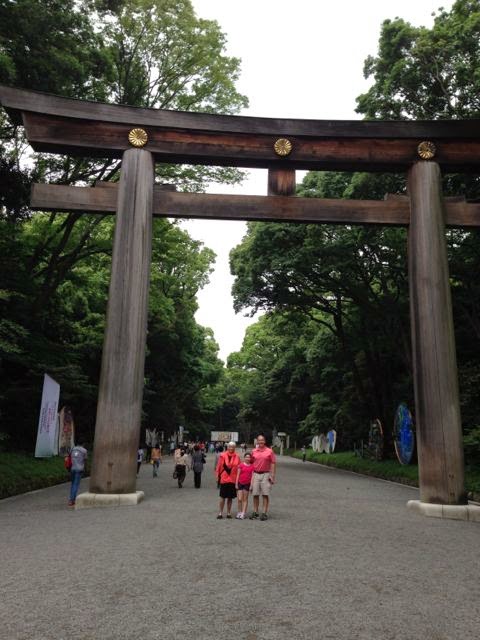 |
| Shinto Gates |
Joyfulness and positive living are the basis of the Japanese Shinto ancient religion. People seem happy to be alive, not complaining, not mulling over the negative, loving to be with family, smiling, respecting (the eternal bows) and believing they are blessed to be here. It’s not an attitude predominant anymore as the American way. And believing God is in all things, the best place to give thanks – for this is not a faith based on sin and evil – is at one of the popular shrines, such as Meiji Jengu. When I asked about the after-life, my guide told us that Shinto is what they live by but many incorporate Buddhist beliefs about death and the afterlife, but not necessarily. They don’t worry about it one way or the other.
 |
| Steam Funk |
On the way to Meiji Jengu, we passed giant lanterns on street corners lighting the way to the holy place. It is an enormous park, a well planned jungle of 100,000 trees donated from all over and planted by volunteer Shinto believers in the 1920s, with wide pathways lined with story telling billboards dedicated to the divine souls of the first Emperor of modern Japan, Emperor Meiji and his consort Empress Shoken. The height and size of the welcoming Meiji gate, through which all must walk, is like a boulder to an ant (we being the ants.) There were many Japanese pilgrims visiting, very few Europeans. Once again, we stopped by the water pool to
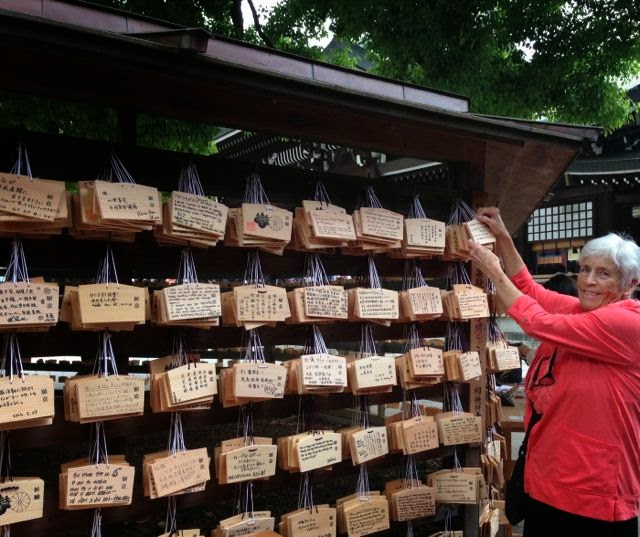 |
| Prayer for Memphis |
cleanse ourselves, pouring water over the left hand, the right hand, and then the mouth. Priests in white kimonos led a worship service and school girls (this is the time of year school children take class excursions) were giggling and eagerly writing on wooden cards their praises and prayers. We, too, purchased the post-card sized prayer cards so we could hang our prayers along with all the rest. Then we tossed coins to accompany our wishes, rounded the prayer off with two claps, two bows and one more clap.
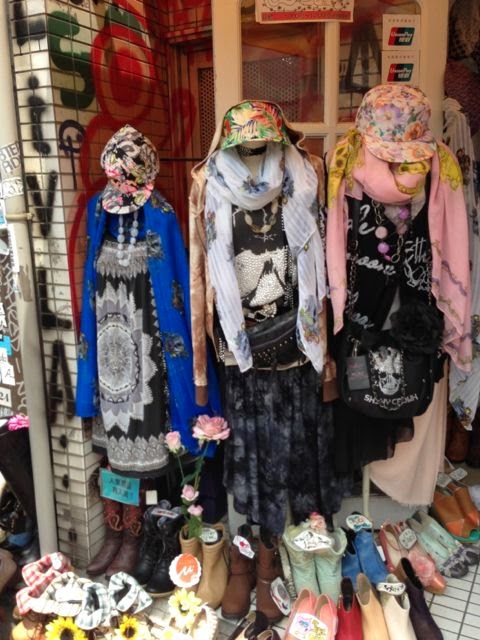 |
| steam funk fashion |
From the peace of this shaded place, we stepped into the fun, high energy area Harajuku, home of Tokyo’s teenage culture. The short street called Takeshita Dori, is filled with the latest fads and fancy of extreme teen fantasies. The latest fad is Steam Funk, which incorporates things from old steam ships and railroads and has a touch of the old West in its style.I loved the small stores filled with punk, funk, Hello Kitty gear, wild socks, wilder sunglasses, sneakers with 6-inch platforms, bright neon mini tutus, and young girls in pigtails dressed in layers devouring the latest craze – pancakes, wrapped like a cone to hold ice cream. Another fad is popcorn, Garrett’s popcorn in fact has a continual line around the block filled with youth on their cellphones and Ipads, waiting for a bag of popcorn for up to a couple of hours. Even pharmacies are jammed pack with pink, purple, yellow and blue makeup and needs – like walking into a toy shop. Everything jammed in, the spirit young and with hope.
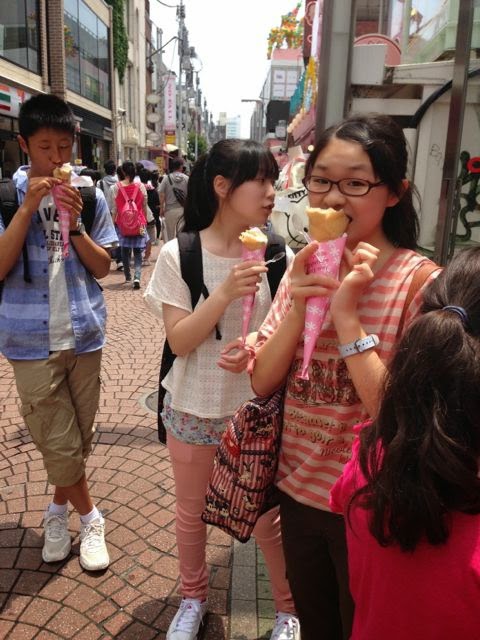 |
| Pancakes – the rage |
From the strange and funky, we walked to the high end shopping area where all the European expensive stores live in incredible architectural environments – Prada, Hugo Boss, Gucci, Dolce & Gabanna, Issey Miyake, Harry Winston. These groups of shopping meccas pop up all over the city. Someone must be spending money whether in Omotesando Avenue or Rappongi. All the streets are tree lined and filled with activity and yet not the disorder and jams of most modern cities. Most Japanese use public transport to get to work. It helps.
 |
| Hugo Boss store |
A quick stop into a small sobu noodle shop (all the restaurants are small so attention and service is on the customer) helped us get our strength up and we drove to our Taiko experience. Taiko is a modern art form of music. There are studios because playing the Taiko drum is major exercise. These fat drums are carved from huge trees.( different sounds from different trees.) Drying takes six to seven years and to finish one drum takes about 10 years. Such drums have been used from ancient times for religious ceremonies in the temples and shrines. Often when touring a shrine, we heard a huge drum sound – and were told it was “used to get God’s attention.” Well, we must have gotten his attention with our banging on odaiko drums.
 |
| Drummers to be |
The style we learned (kumi-daiko) is credited to Daihachi Oguchi, a jazz drummer wjho jappened upon an old piece of taiko music and performed it for the Osuwa shrine. We took off our shoes and entered a sound-proof studio filled with drums and a mirrored wall.
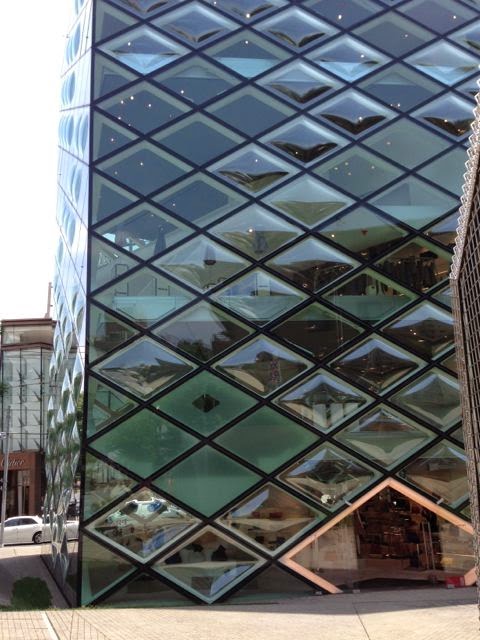 |
| Prada Store |
Starting from knowing nothing but rhythm, we pounded out complicated patterns that made me realize dementia has not yet set in (Ha.) James, Caroline and I, by chance dressed in salmon and pink, were led into a padded studio by our teacher, who spoke no English, but our amazing guide translated as we moved forward to learn the art. After a one hour class (in air conditioning) we were all heavy with sweat, filled with enthusiasm and pride that we had done it, and secretly pleased to have gotten a different kind of exercise. The drum vibrations we caused must have been healthy. Caroline stole the show with her smile and antics. We also had good cause to visit a small but elegant chocolate – pastry shop (mostly French Macarons) owned by one of the 10 top chefs in the world, Aoki, who lived and was trained in France but returned to his home in Japan to open a couple of exclusive shops.
 |
| Uruguayan Architect |
Kobe beef. Even I, the vegetarian, agreed to stir up old tastebuds and eat the best beef in the world. The appetizer was beef tartare (too good to describe) and then the filet – if beef were butter itself, it could not have been tenderer nor more flavorful. The Master Chef, who spoke some English, made sure we had the right stuff. Having seen the beef in the market which is so laced with fat (not clumps but veins) we were primed to see what the affect was. Understand: Kobe cannot be duplicated anywhere else. It must be from the Tajima strain of waygu cattle raised in Hyogo Prefecture. Efforts to duplicate never come close to the real thing. (Hmmm – there is a USA Kobe who dunks). And it is expensive but worth every bite.
